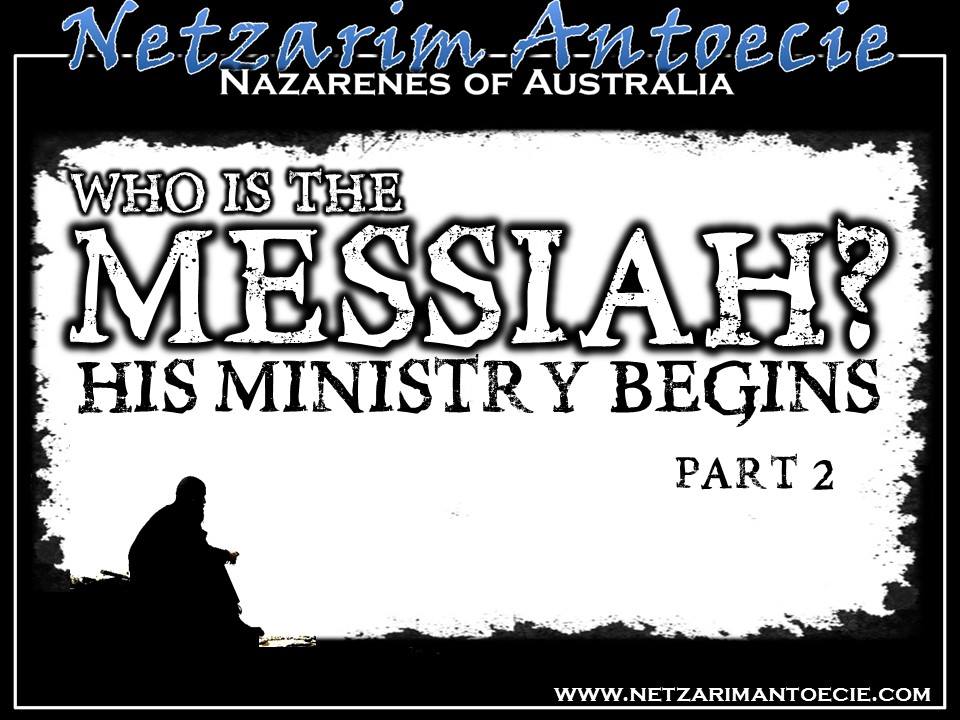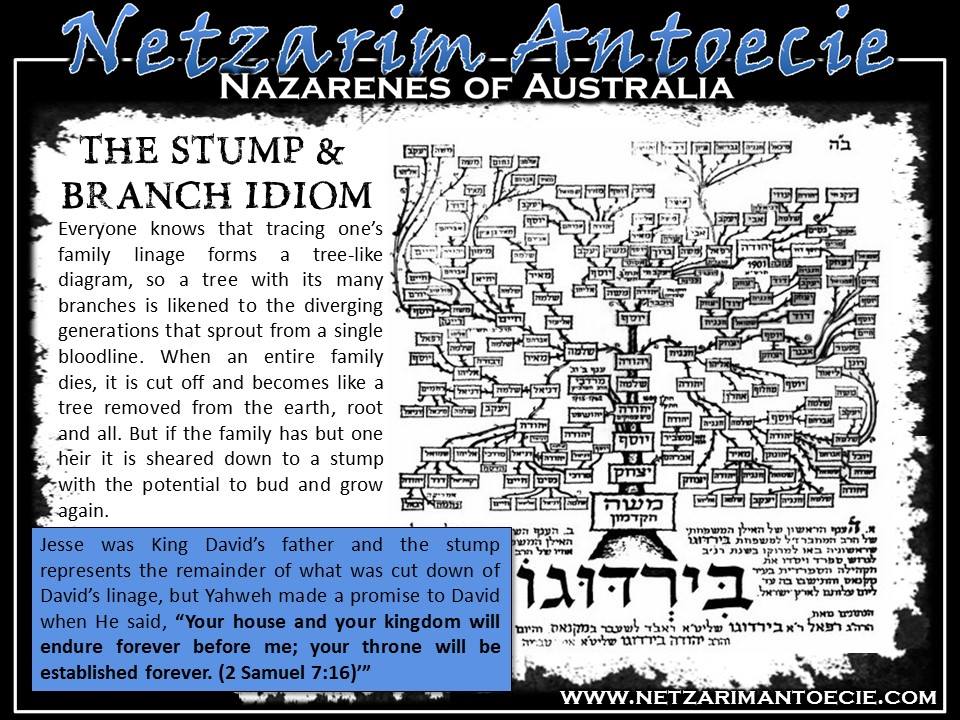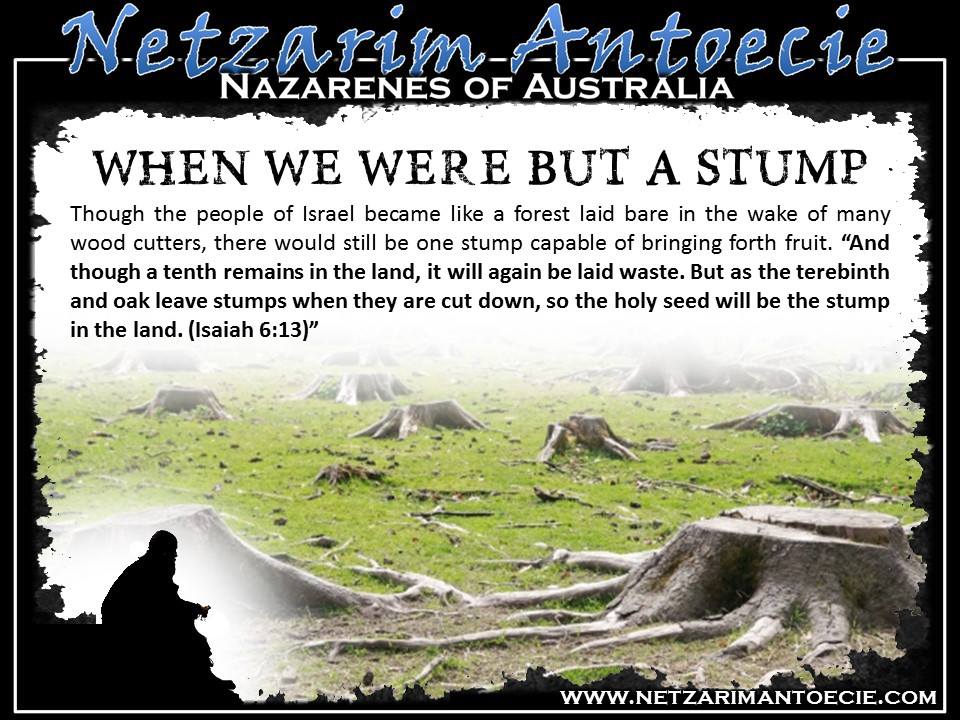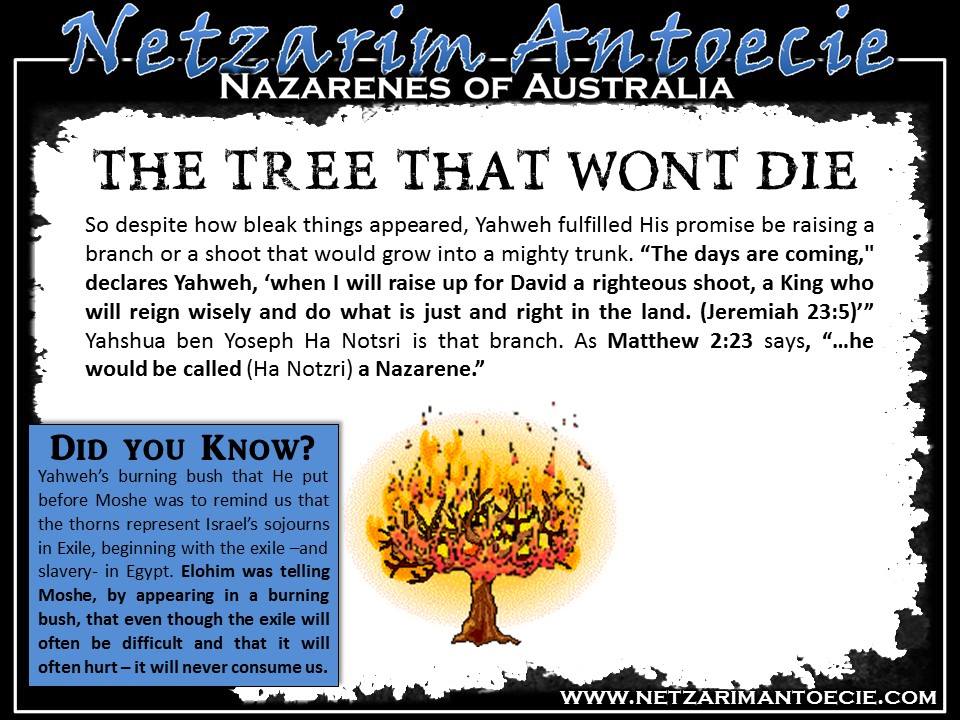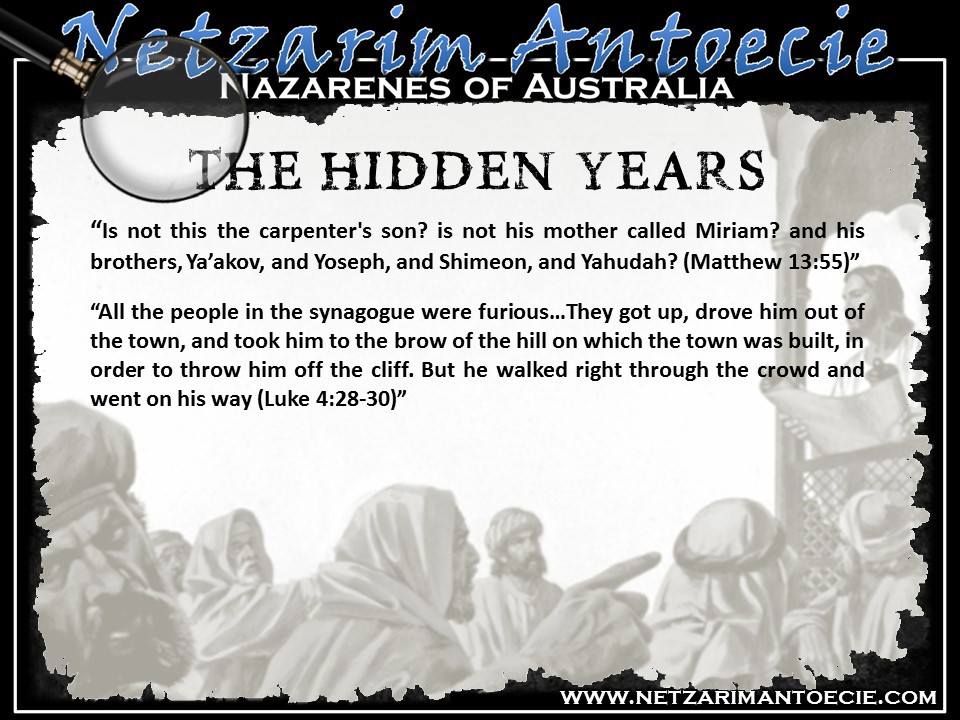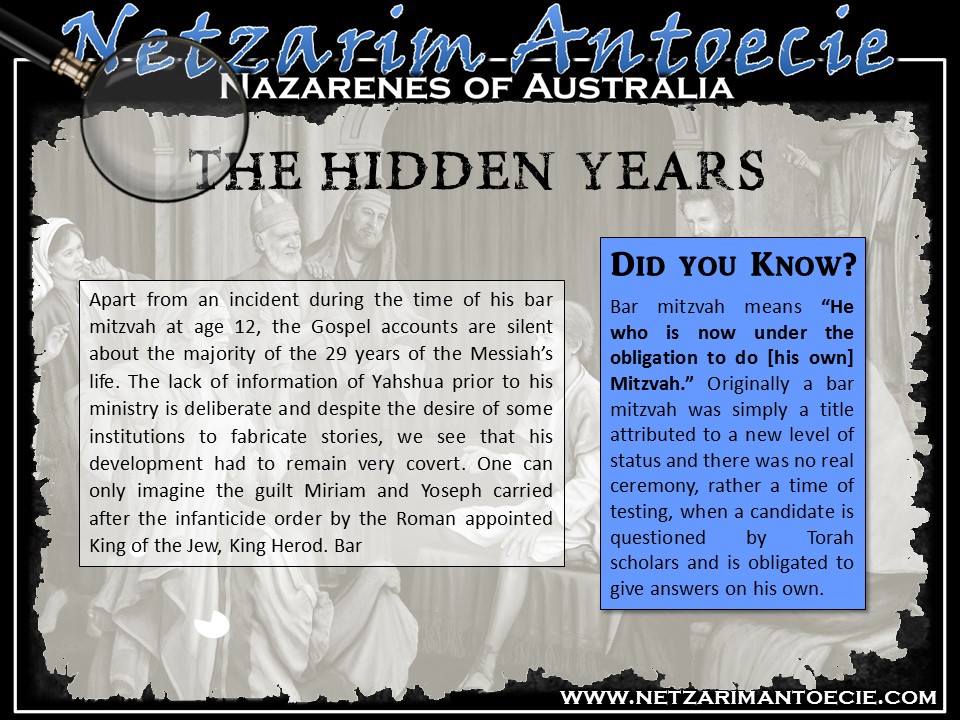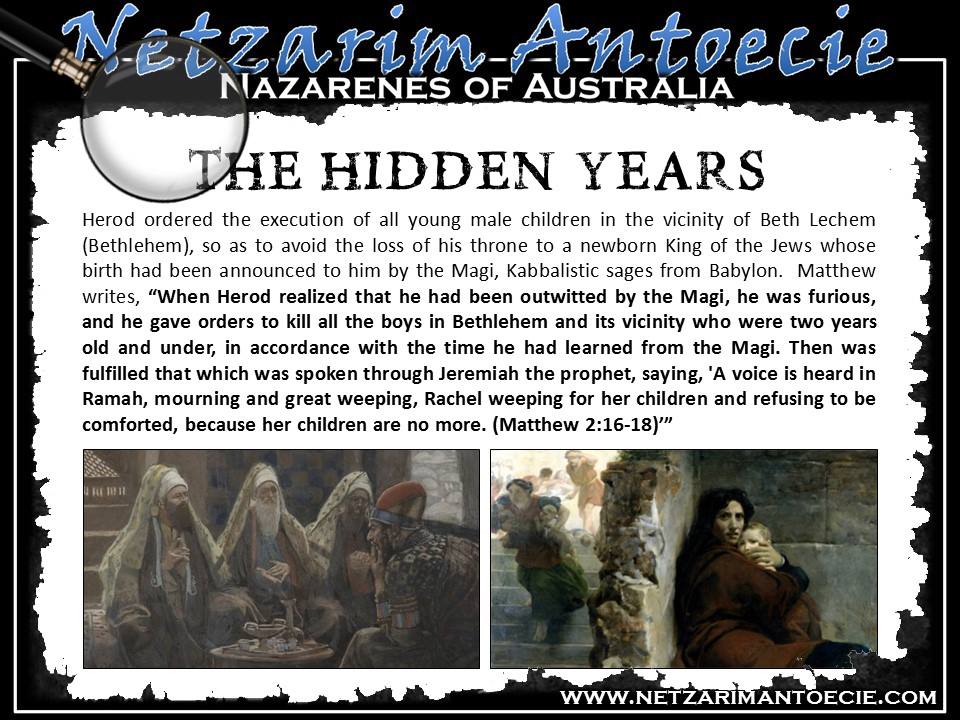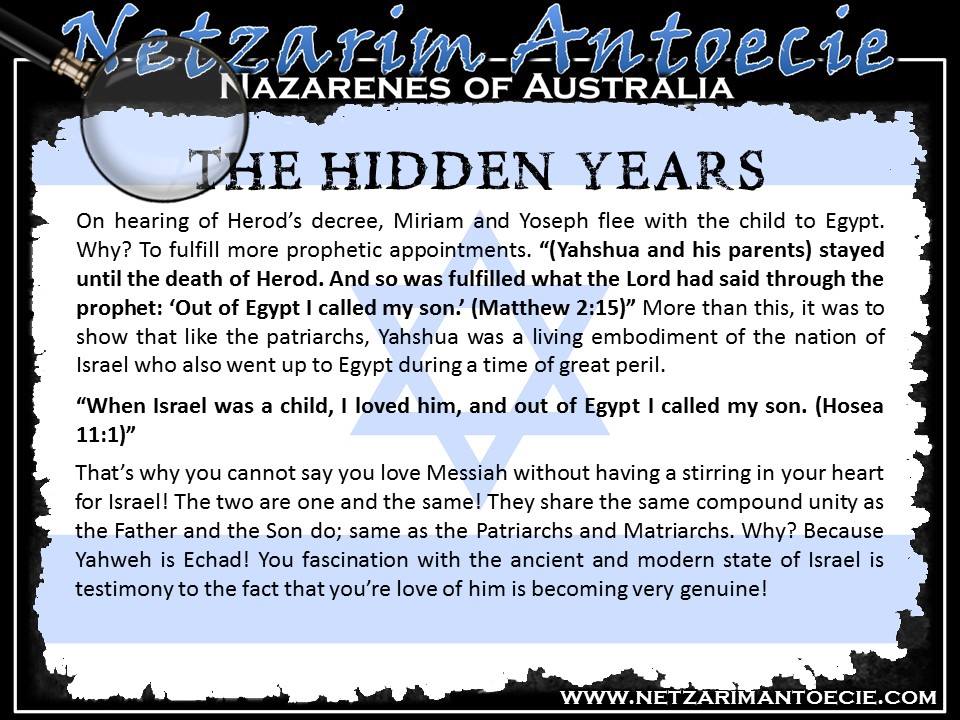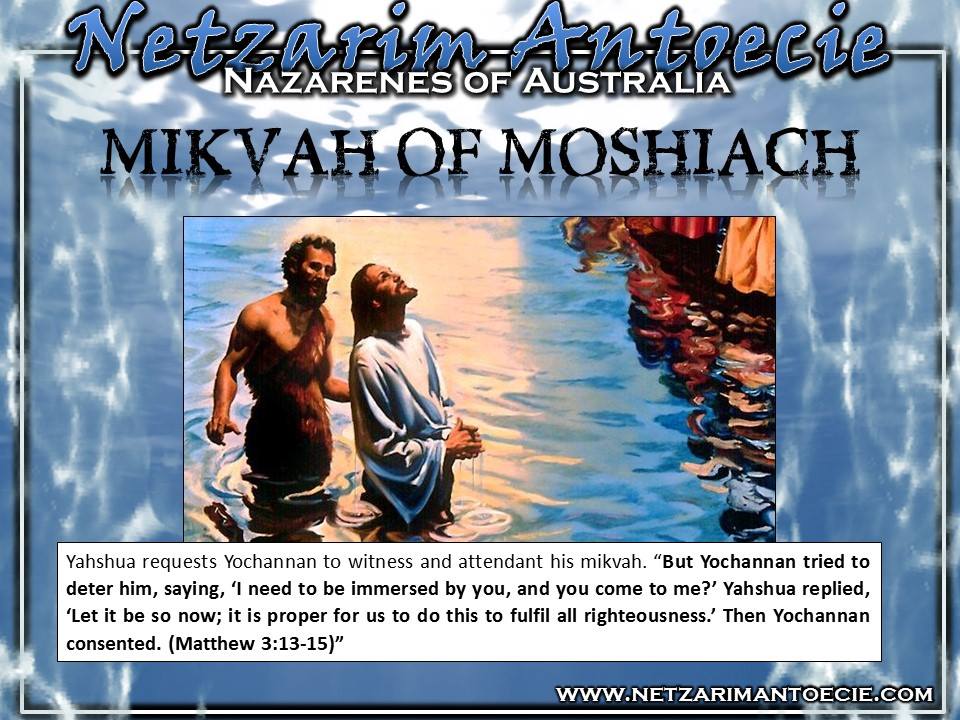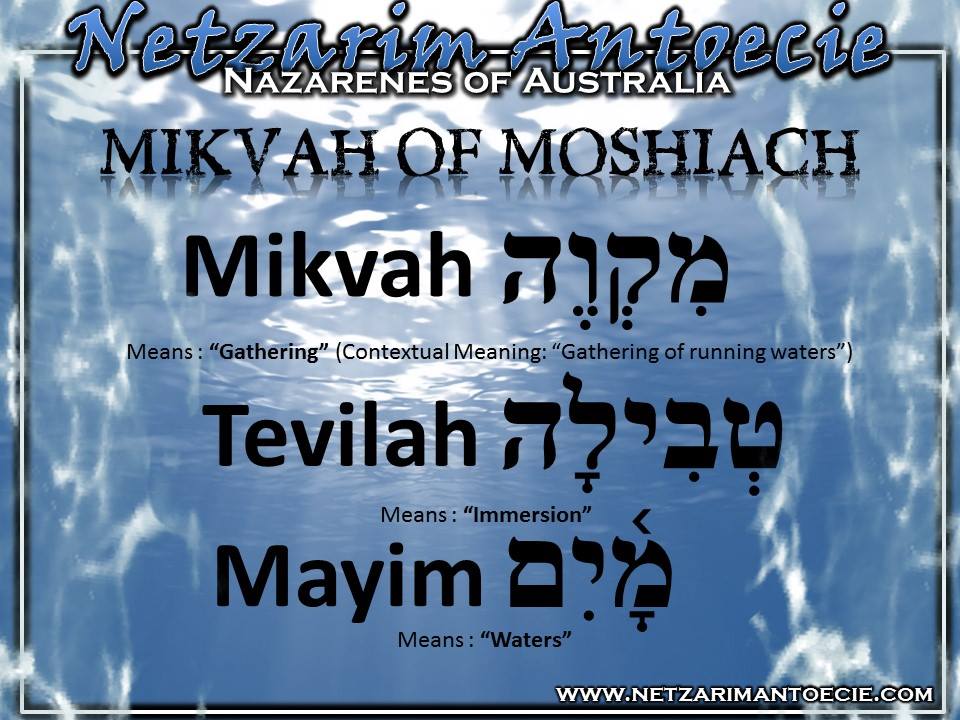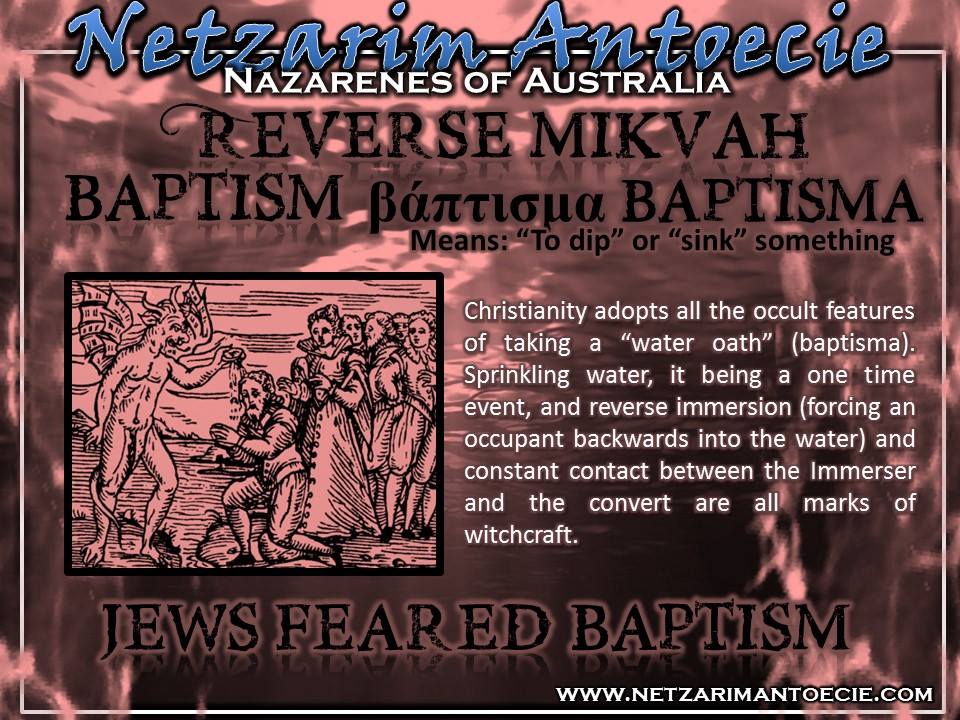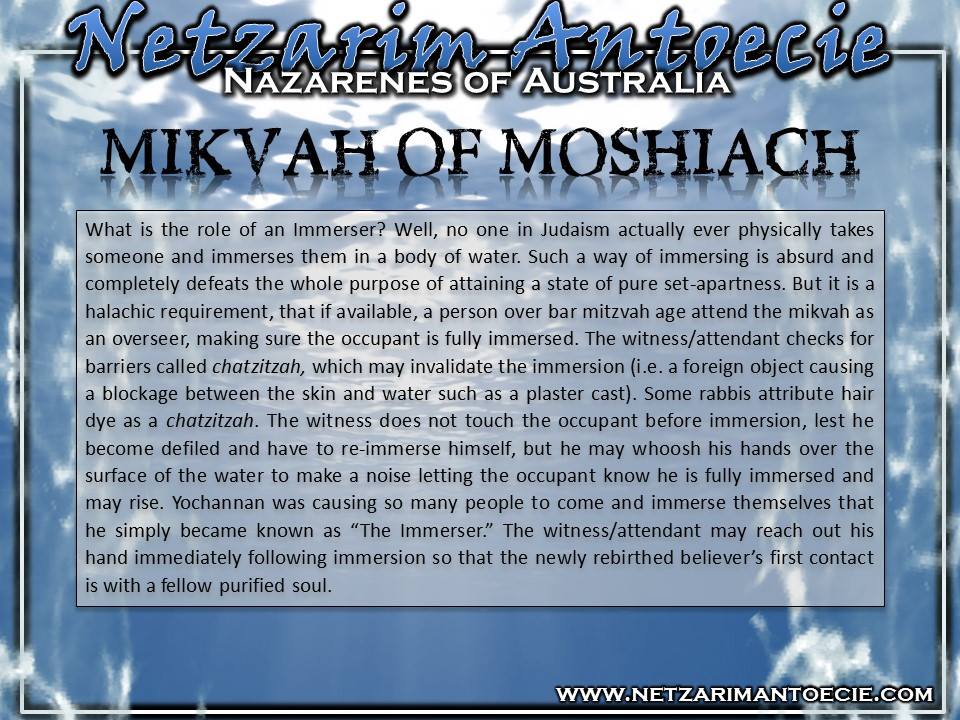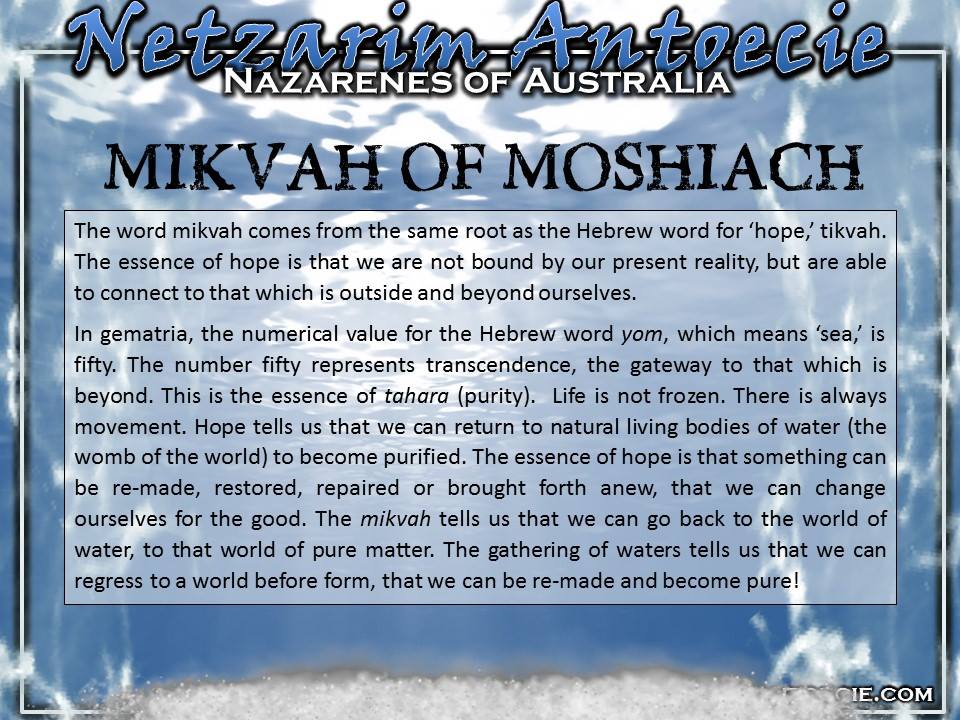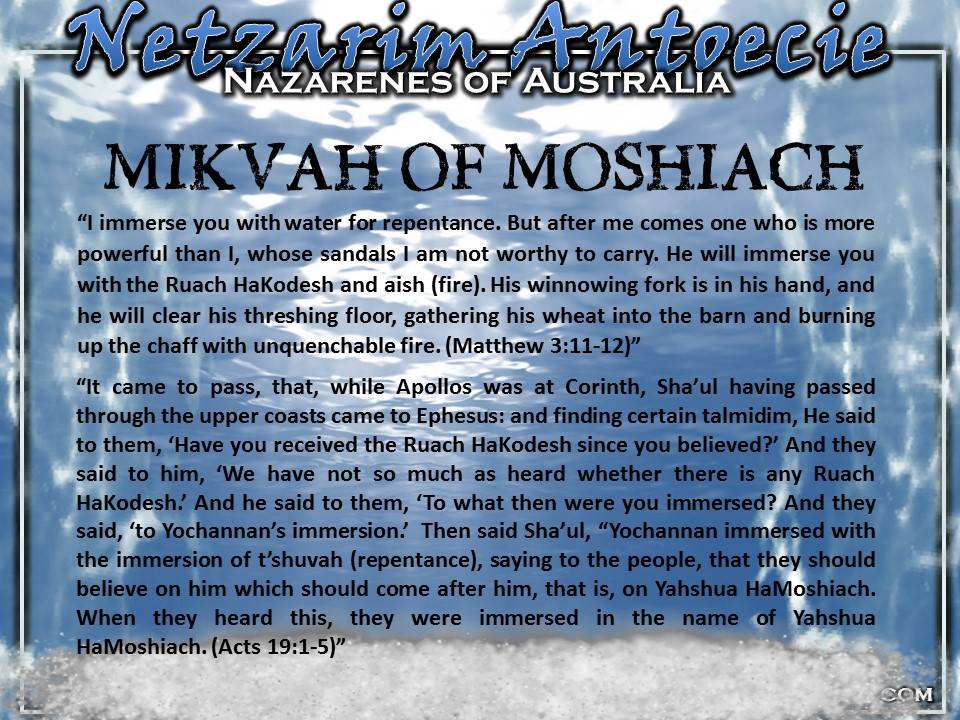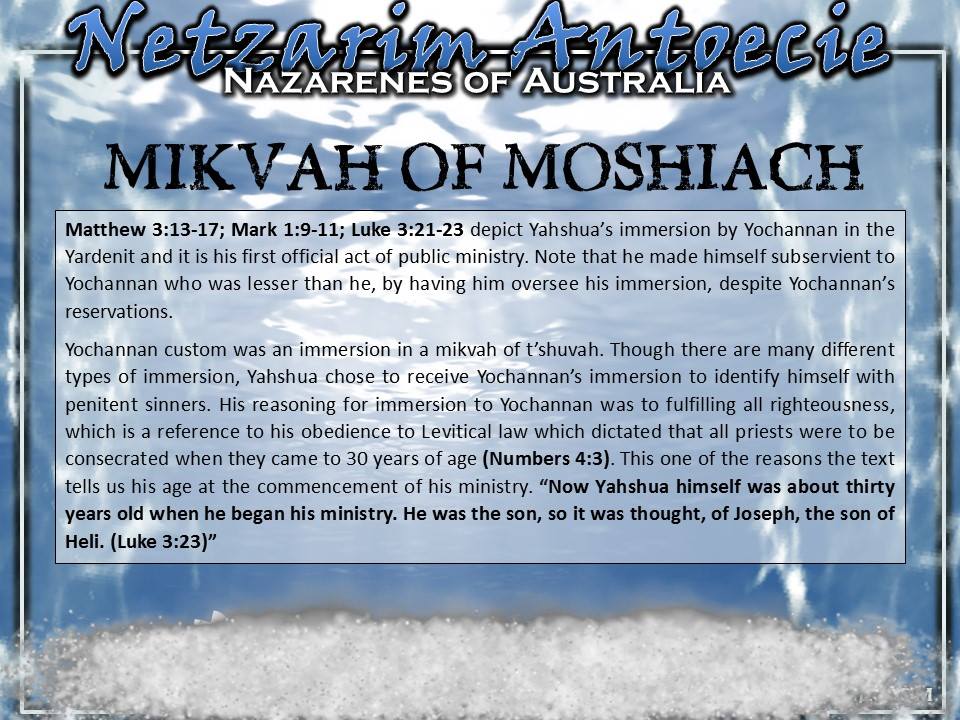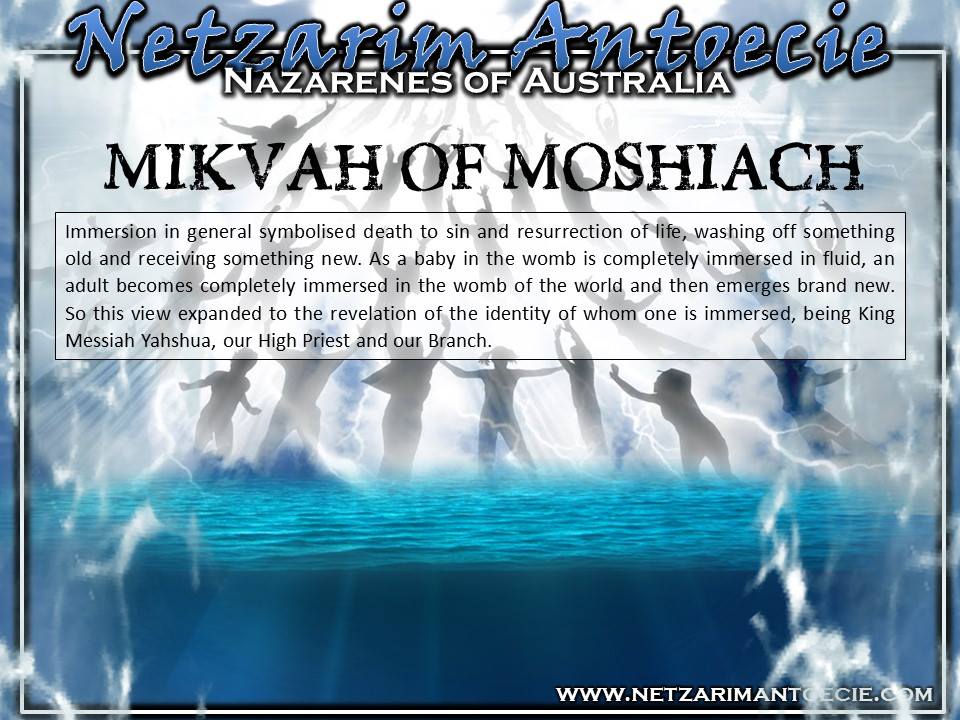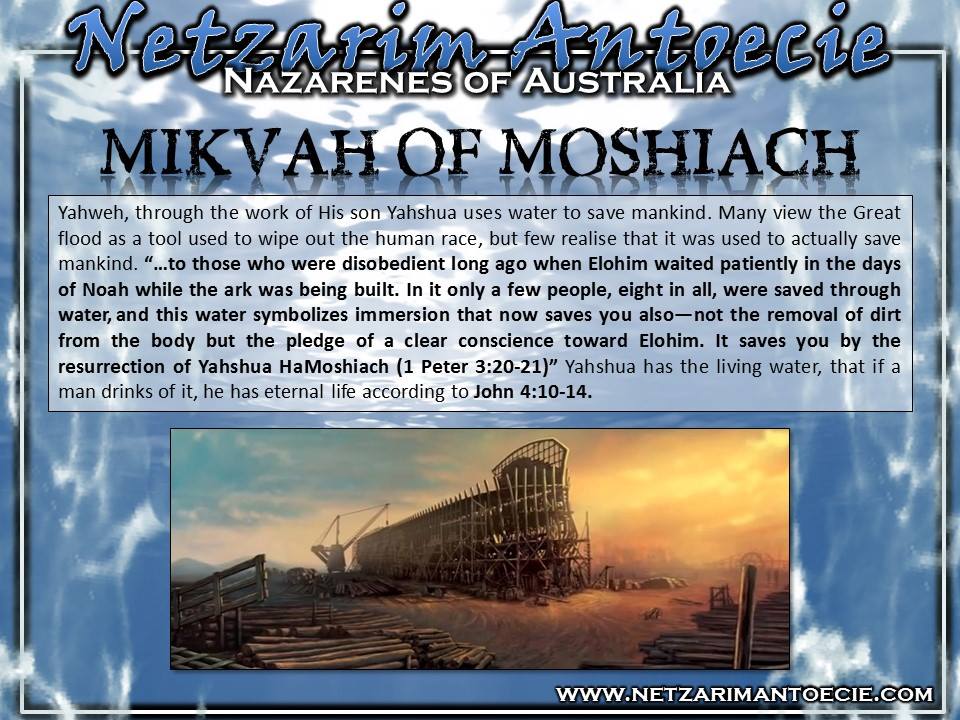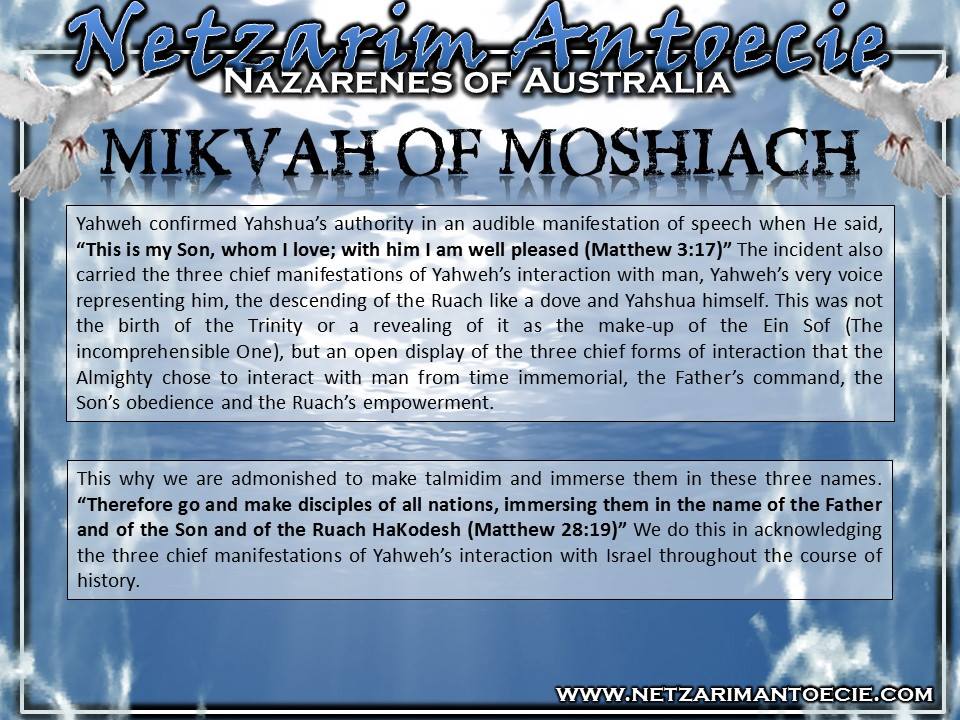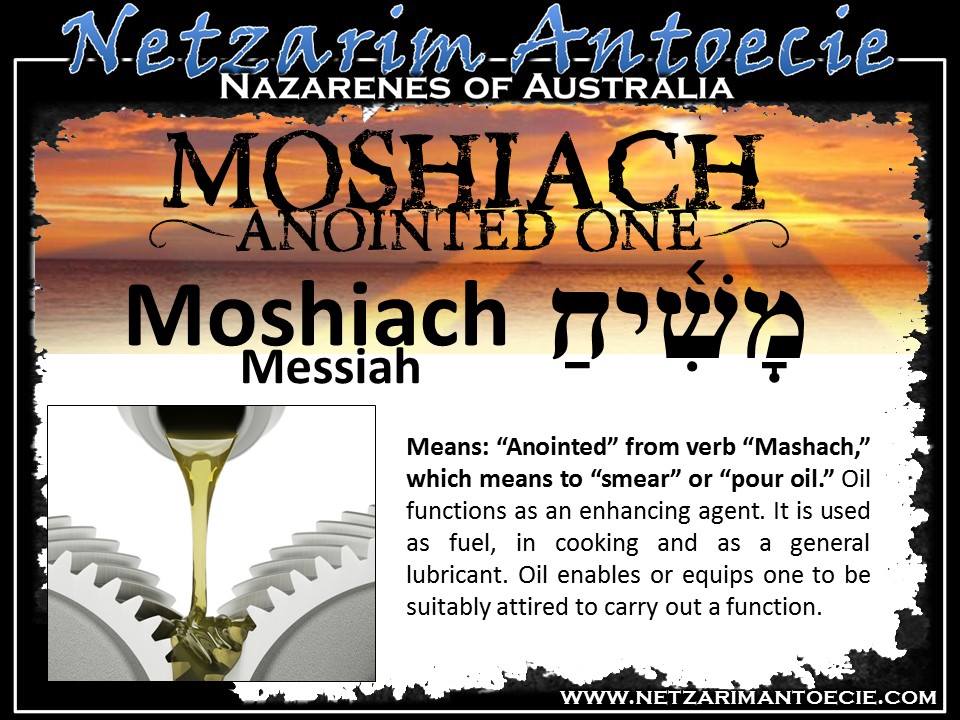Who Is the Messiah? – The Miracles Begin - Part 4
Video Teaching
PLEASE NOTE: Video teaching is being uploaded please check back shortly, Thank you.
Study Notes and Slides
(Slide) Yahshua HaNotzri came in the wake of the bulldozer of sinners with penitent hearts, Yochannan HaMatbil (John the Immerser). Yochannan levelled the ground for a smooth landing and a handing over of the baton of Yahweh’s will to the next accelerant – King Messiah Yahshua.
Yochannan was the rightful High Priest of the A’aronic priesthood, exiled to the wilderness and crying out for man to grasp the reality of truth. This is why Yahshua went to him. According to Jewish law, he should have gone up to Jerusalem and presented himself to the High Priest and before the Sanhedrin. But the High Priest in Jerusalem in Yahshua’s day was illegally appointed by the Judea’s current occupiers – Rome. Added to this, many of the Sadducees and Pharisees were impostors. They were either wrongfully appointed or on King Herod’s take.
Yahshua’s mikvah was an anointing, but it was also an act of consecration by him to his new ministry as High Priest. It was by no coincidence that Yochannan soon fell to Herod’s sword, for while there is an A’aronic Priest, the High Priest of the Order of Melchizedek cannot resume his office. Remember, the A’aronic Priesthood is an interim Priesthood.
(Slide) Later, when Caiaphas rent his garment (Matthew 26:65), even though his appointment was suspect, this act openly displayed his inadequacy, disqualifying the whole framework of the current priestly service. “And he that is the Kohen HaGadol (High Priest) among his brethren, upon whose head the anointing oil was poured, and that is consecrated to put on the garments, shall not uncover his head, nor rend his clothes. (Leviticus 21:10)” This is why the Temple had to be destroyed. If the Temple stands, it has to be adequately manned. Tearing the High Priest robes was akin to profaning Elohim’s character. It’s ironic that Caiaphas made himself guilty of the very law he was appearing to defend. In fact, the penalty for tearing priestly garments was death.
From this point, Yahshua became our High Priest, having being publically consecrated to assume office. When the Ruach fell, much later, this symbolised the Father’s acceptance of his office through the shedding of his blood.
(Slide) Now when Yahshua underwent Mikvah, the Ruach HaKodesh came upon him. Now though t’shuvah (repentance) was central to Yochannan’s ministry and immersion, t’shuvah is not the only reason one immerses. One who sins infrequently still requires regular immersion for matters of bodily uncleanness. The human body by definition is subject to impurities that have nothing to do with sin. Messiah was without sin, but he himself was not above his own Father’s instruction, which required one to be born of water and of spirit. “I will sprinkle clean water on you, and you will be clean; I will cleanse you from all your impurities and from all your idols. I will give you a new heart and put a new Ruach HaChadash (renewed spirit) in you; (Ezekiel 36:25-26a)”
(Slide) This means that this two-fold process is a requirement for eligibility into the Kingdom of Elohim, that of a water and spiritual birth. Water and air are among the most abundant things on earth. Yahweh is not stingy with such a critical requirement. Nor is one denied salvation if they don’t receive Mikvah. Rather it’s a natural course of action in the process of one’s walk after receiving salvation.
Water into Wine
(Slide) The concept of water and spirit is linked to Yahshua’s very first miracle. Note what Messiah Yahshua said to Rav Nichdimon (Nicodemus) during their secret meeting: “Yahshua answered, ‘Very truly I tell you, no one can enter the kingdom of Elohim unless they are born of water and the Spirit. (John 3:5)’” What was Yahshua’s first miracle? It was turning water into wine! These waters at the wedding feast weren’t just any waters. They were waters of ritual purification. The water Yahshua transformed to wine, was the same waters the Jews used to purify themselves.
(Slide) “On the third day a wedding took place at Cana in Galilee. Yahshua’s mother was there, and Yahshua and his talmidim had also been invited to the wedding. When the wine was gone, Yahshua’s mother said to him, ‘They have no more wine.’ ‘Woman, why do you involve me?’ Yahshua replied. ‘My hour has not yet come.’ His mother said to the servants, ‘Do whatever he tells you. (John 2:1-5)”
“On the third day…” The third day of the week, Tuesday is the preferred day for weddings in Israel because on the third day of the creation week, Elohim pronounced things “good” twice (Genesis 1:10,12); the only time He did so in the seven days of Creation. Therefore the third day is known as a day of double blessing, the best day of the week to begin a new life.
“…a wedding took place at Cana in Galilee.” The mention of this wedding symbolised the Wedding Feast of the Lamb, when Messiah Yahshua marries his bride (Israel), reminding us that the beginning of a matter is wedge in the end and the end of a matter is wedged in the beginning. The town Cana (Chanah) represents creation. The root-verb קנה (qana) means to acquire or create. The name Channah means “gift from Elohim” and Chanukah means “to dedication.”
“Woman, why do you involve me?’ Yahshua replied. ‘My hour has not yet come.’” The request from Yahshua’s mother represents an acknowledgment of a waning joy and hope and the crying out for Moshiach to be hastened. So from this we know that Messiah can come before a predesignated time if we continue to tarry with him.
(Slide) Furthermore, the phrase, “why do you involve me” is actually a Hebrew Idiom used five times throughout the TaNaK, which actually should read, “What to me and to you?” which means, "What has it to do with you and me?" In other words, ‘You have perceived that something is wrong, so you want me to intervene now?’ This eludes to the remedy (Messiah) that has been prepared before the sickness (sin). The use of the title “’woman’ over ‘mother’ denotes the seed of a woman who will overcome the serpent. What will it be overcome by? The blood, represented by the wine, which the guests comment is better than this first wine (the first blood, that of animals), which is not as good as the latter blood – the shedding of Messiah’s blood. Miriam asks for new wine. Why? “How wonderful and beautiful they will be! The young men will thrive on abundant grain, and the young women will flourish on new wine. (Zechariah 9:17)”
(Slide) “But there were there six water casks of stone, set for the purifying of the Judeans, which held two or three nine-gallon-measures each (twenty or thirty gallons). (John 2:6)” Also note the six stone casks. These correspond to the six tasks that Moshiach has to accomplish.
These are called the six Messianic Expectations:
- The correct genealogy.
- Be anointed King of Israel.
- Return Israel back to the promised land
- Restore the Temple in Jerusalem.
- Bring peace to the world and end all war.
- Bring knowledge of Elohim to the world.
These six tasks are derived from the six things that Adam lost after the fall!
Yahshua is six things: He is the Word (dvar or memra) (John 1:1), the Light (John 1:4), the Son Elohim (John 1:14), Lamb of Elohim (John 1:29), Messiah (John 1:41), and being the Sovereign (John 1:49).
Each water cask contained 30 gallons of water. There were 6 casks totalling 180 gallons of water corresponding to the 180 years of Yitzhak’s (Isaac’s) life. The Binding Yitzhak, known as the Akedah in Genesis 22 was a type of Moshiach.
(Slide) Here we get to the true spiritual significance of these large water casks for purification. Messiah is making a statement about purification. Water purifies, but so too does the spirit, represented by transforming the water into alcohol, a product that is symbolic of the Spirit. In this case it is wine. Fermented grapes also represents Messiah’s blood.
Messiah symbolically drew blood from within stones. Remember the idiom, “It’s like drawing blood from a stone,” which denotes trying to do the impossible. Well, Messiah’s first miracle was on this extreme level.
(Slide) Just as in an actual birth of a child there is water and blood, so the new birth, must also be by water and blood.
“This is the one who came by water and blood—Yahshua HaMoshiach. He did not come by water only, but by water and blood. And it is the Ruach who testifies, because the Ruach is emet (the truth). (1 John 5:6)”
The guests consume the wine, symbolically partaking of Messiah’s blood, which would be shed for the remission of sin. "Behold, I will stand before thee there upon the Rock in Horeb; and thou shalt smite the Rock, and there shall come water out of it, that the people may drink... (Exodus 17:6)" Yahshua is our rock of salvation according to Psalm 62:2 and he was smitten and out poured his blood. So it is confirmed that the beginning of a matter is wedge in its end and the end of a matter is wedged in its beginning, because when Yahshua was pierced out came water and blood. “…one of the soldiers pierced Yahshua’s side with a spear, bringing a sudden flow of blood and water. (John 19:34)”
(Slide) This incident also connects Messiah to the water libation ceremony that is carried out at the conclusion of Sukkot, where water and wine is poured out togther.
“And on the great day, which is the last of the feast, Yahshua stood and cried out and said, ‘If anyone thirsts, let him come to me and drink. Whoever believes in me, as the Scriptures have said, rivers of water of life will flow from his belly. (John 7:37-38)’” The occasion of this event is the last great day of Sukkot (John 7:2) and the setting is the water libation ceremony at the Temple. A priest had a flask of gold filled with water and another has a flask of gold filled with wine. There were two silver bowls perforated with holes like a narrow snout. One was wide for the water the other is narrow for the wine. The priests poured the wine and water into each of their bowls. The wine and water mixed together. The wine flowing slowly through the narrow snout and the water flowing quickly through the wider snout.
(Slide) Who is the Messiah? He is Yahshua, the Rock. The rock that contains the water of rebirth and spirit of redemption that comes in fire. “Yahweh is my rock, my fortress and my deliverer; my Elohim is my rock, in whom I take refuge, my shield and the horn of my salvation, my stronghold. (Psalms 18:2)”
(Slide) Now, it’s not a popular message, but here goes. You can either take Yahshua up as your shield (Psalm 18:35) by taking up two inverted daletot, two corner stones, rejected by the builders of the Torah, or you can walk away. But in time Yahshua, the rock which was supposed to be your help, will become your end. That’s why capital punishment usually comes in the form of stoning. It represents Yahshua, who should be a person’s magen, his shield of salvation, but instead to a disobedient person who refuses to repent, he becomes a stone that causes injury and even death.
(Slide) “Then (David) took his staff in his hand, chose five smooth stones from the stream, put them in the pouch of his shepherd's bag and, with his sling in his hand, approached the Philistine. Meanwhile, the Philistine, with his shield bearer in front of him, kept coming closer to David. He looked David over and saw that he was little more than a boy, glowing with health and handsome, and he despised him. He said to David, "Am I a dog, that you come at me with sticks?" And the Philistine cursed David by his elohim. And the Philistine said to David, Come to me, and I will give your flesh unto the birds of the heavens, and to the beasts of the field. David said to the Philistine, ‘You come against me with sword and spear and javelin, but I come against you in the name of Yahweh Almighty, the Elohim of the armies of Israel, whom you have defied. This day Yahweh will deliver you into my hands, and I'll strike you down and cut off your head. This very day I will give the carcasses of the Philistine army to the birds and the wild animals, and the whole world will know that there is an Elohim in Israel. All those gathered here will know that it is not by sword or spear that Yahweh saves; for the battle is Yahweh’s, and he will give all of you into our hands.’ As the Philistine moved closer to attack him, David ran quickly toward the battle line to meet him. Reaching into his bag and taking out a stone, he slung it and struck the Philistine on the forehead. The stone sank into his forehead, and he fell face down on the ground. (1 Samuel 17:40-49)”
David gathered up five smooth stones. Why? Each stone represented five of the Messianic Expectations, with he, himself, be the fulfilment of the sixth (the genealogy).
- The correct genealogy.
- Be anointed King of Israel.
- Return Israel back to the Promised Land
- Restore the Temple in Jerusalem.
- Bring peace to the world and end all war.
- Bring knowledge of Elohim to the world.
All five stones and David himself represented Messiah. Notice, he kept them in a shepherd’s pouch. For years we’ve looked at the law of stoning as if it was a rabbinic observance, seeing it mishandled with the incident with the adulterous woman and the stoning of Stephen. But, if it is executed correctly, the cast stone represents Messiah who vanquishes our enemies.
(Slide) The Hebrew word for “stone” is even, spelled alef, beit, nun. This is an acronym for av ben, which means, “father son.” Every stone is the union of father and son.
(Slide) David slew Goliath with a sling and stone. A sling is made out of natural materials that are readily available in the wilderness and the stone is as plentiful as the dust under one’s feet.
We’ll take a moment to watch this short video to see the lethality of the simple stone and sling. Watch carefully at the speed and accuracy of the stone as it is launched from the sling.
(Slide) Where did David hit Goliath? The forehead, the Gulgoleth (Golgotha), the skull! With what? A stone! This alludes to Messiah’s victory at the place of the first skull – Adam’s skull.
Every attack of the enemy is directed at the mind. It is the enemy’s goal to cause us to make a decision against what we know is right, and to make repeated wrong decisions, become comfortable with these wrong decisions and have us repeat them so often that it feels impossible to take another course of action.
We see that Yahweh, with great effect, uses the stone to damage and to preserve.
We must remember that a stone can be used to help or hurt us, wine can be used to relax or inebriate us and water can drown or renew us. It’s all in how we use them.
These are just some of the gleanings found in Yahshua’s miracle of changing water into wine.
Defining Miracles
Before we go any further, let’s look at the concept of miracles. What are miracles?
(Slide) “Now concerning spiritual gifts, brethren, I do not want you to be ignorant…There are diversities of gifts, but the same Spirit. There are differences of ministries, but the same Sovereign. And there are diversities of activities, but it is the same Elohim who works all in all. But the manifestation of the Spirit is given to each one for the profit of all: for to one is given…the working of miracles…But one and the same Spirit works all these things, distributing to each one individually as He wills. (1 Corinthians 12:1,4-8, 10, 11)”
Miracles are a gift! Working miracles within the body are often like the big gun that everyone in a survival video game wants to carry and use. No one usually fights over who is doing first aid or carrying the radio. Many want to do miracles, healings, deliver prophecy or teach!
The Gift of the Working of Miracles is a manifestation of the Spirit of Yahweh that comes in the form of a supernatural act. In other words, every occurrence which contrasts with the ordinary happenings of life is counted a miracle or wonder. Miracles are not meant to just comfort or convenience humankind. Miracles show Israel how deeply Yahweh cares.“…that you may know what is the hope of His calling, what are the riches of the glory of His inheritance in the saints, and what is the exceeding greatness of His power toward us who believe, according to the working of His mighty power, which He worked in Messiah when He raised Him from the dead and seated Him at His right hand in the heavenly places…(Ephesians 1:18-20)”
(Slide) The greatest miracle of all is that Yahweh is working His mighty power in King Messiah YahShua through us as an expression of manifesting His will in Heaven to earth.
The word miracles comes from the Greek word dunamis which means "power and might that multiplies itself." The Gift of the Working of Miracles operates closely with the power gifts of faith and healings to bring authority over the Sitre Ahura (Dark Forces), sickness, sin, and the binding forces of this age.
Miracles come in the wake of ministry not in the front of it. Miracles confirm ministry. “…these signs will follow those who believe: ‘In My name they will cast out demons; they will speak with new tongues; they will take up serpents; and if they drink anything deadly, it will by no means hurt them; they will lay hands on the sick, and they will recover.’ So then, after the King had spoken to them, He was received up into heaven, and sat down at the right hand of Yahweh. And they went out and preached everywhere, the King working with them and confirming the word through the accompanying signs. Amien. (Mark 16:17-20)”
(Slide) The Torah lays down the principle that miracles are no test of the truth of the thing for which their testimony is invoked. “If a prophet arise among you who giveth a sign or wonder, and the sign or wonder comes to pass, but he desires to lead you into idolatry, you shall not hearken to that prophet, for Yahweh your Elohim is trying you to see whether you truly love Yahweh your Elohim (Deuteronomy 13:1-3)” Miracles alone do not prove a religious truth, as they are performed also in the cause of untruth. But truth accompanied by miracles prove truth. We are expected to not put or faith in a truth based on a miracle alone, but put our faith in a truth because it is truth alone and let a miracle confirm it.
(Slide) The Hebrew word for miracle is nes. It is the same Hebrew word for flag pole. A miracle is an elevated event. Something extraordinary that happens, allowing us to see Elohim’s hand clearly.
(Slide) Turning the water into wine is not the miracle. Anyone of us can turn water into wine, it takes a little time. You have a grape vine, you pour water at the base, you tend it, grow grapes, pick them off, crush them and you make wine. Water turns into wine. But it doesn't happen instantly. The miracle in the water and the wine is the time. King Messiah YahShua transcended the time. Here we have this wedding in Canaan of Galilee and you have six full water pots for the water of purification. That's the first miracle in the story, He was proclaiming himself the Messiah. I have the authority to take charge over the water that makes clean, that is the most holy . I, and I alone, can command you to fill those jars. That's the miracle.

















































